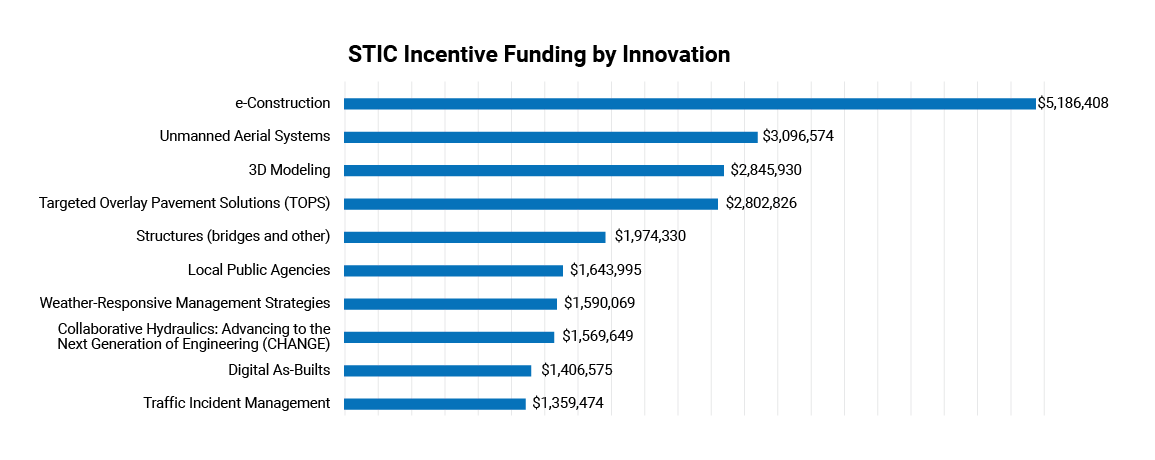
FHWA’s STIC Incentive Program: A Decade of Helping Move Innovative Solutions into Everyday Practice
Over the past 10 years, State Transportation Innovation Councils (STICs) have brought good ideas into mainstream use with help from funds offered through FHWA’s STIC Incentive program. Now in its 10th year, the program has provided approximately $40 million to support efforts to improve transportation project delivery as well as create a culture of innovation that will continue to nurture good ideas and move them forward.
The STIC Incentive program provides up to $125,000 in Federal funds per STIC per Federal fiscal year to support or offset the costs of standardizing innovative practices. The STICs, which are active in all 50 States, the District of Columbia, Puerto Rico, the U.S. Virgin Islands, and Federal Lands Highway, can use the funds to support one project or multiple smaller projects deploying innovations from the EDC program or other topics. STIC Incentive funds provide a Federal share of 80 percent on a project, and project sponsors supply the 20 percent non-Federal match.

The top 10 innovations funded over the past 10 years through FHWA’s STIC Incentive program.
Credit: FHWADriving Innovation
In 2014, the New Hampshire STIC was the first to receive STIC Incentive funds from the new program, dividing the funds among three projects: developing a State historic architectural and archeological resource database that the New Hampshire Department of Transportation could use to streamline programmatic agreements, developing design standards to support use of 3D engineered models for construction, and employing an innovative approach to collecting data for pavement and bridge projects using ground-penetrating radar equipment and software.
In an Innovator article highlighting these first STIC Incentive projects, the New Hampshire FHWA Division Office noted that the extra dedicated funding is what was needed to make these activities a priority and encouraged other STICs to take advantage of the incentive funds by looking for the small opportunities that can make a big difference. Sharing a similar message, Pennsylvania’s STIC created videos highlighting the State’s deployment of the Geosynthetic Reinforced Soil-Integrated Bridge System and expansion of its Traffic Incident Management (TIM) training capability to show just how far $100,000 can go to help advance innovation statewide.
Pennsylvania’s STIC created a video highlighting its use of STIC Incentive funds to deploy the Geosynthetic Reinforced Soil-Integrated Bridge System.
Credit: Pennsylvania Department of TransportationSTIC Incentive projects have included a Missouri DOT (MoDOT) system for advancing TIM data collection that combines incident and work zone data with probe data in one system to enable better analysis, reporting, and situational awareness. MoDOT uses the combined data on performance measures in its statewide tracker, and the agency’s Southwest District is using the data to create visualizations of congestion from crashes for incident after-action reviews.
The Vermont Agency of Transportation used STIC Incentive funds to develop design-build documentation and tools, including a sample request for qualifications (RFQ) and RFQ scoring criteria, an example design-build schedule, a process for using alternative technical concepts with design-build, and an alternative delivery decision matrix.
The Wisconsin DOT used STIC Incentive funds to develop and implement its Standard Bridge Design Tool, which produces standardized plans for local roadway bridges. By automating a large portion of the design and drafting work for this type of structure, the tool decreases the monetary resources needed within the design phase of relatively simple bridge projects.
The Virginia Transportation Research Council (VTRC) applied STIC Incentive funds toward a wildlife fencing project that is improving safety by substantially lowering the number of deer-vehicle collisions along a busy interstate corridor. The first year after installation, VTRC recorded a 90-percent reduction in deer-vehicle collisions. After 2 years, VTRC reported the cost savings of fencing averaged over $2.3 million per site.
Find out more about which technologies and practices STICs in each State are advancing by visiting the FHWA STIC Incentive Projects webpage. This extensive list of projects, created over the past 10 years and counting, serves as a resource for the highway community to explore and pursue small opportunities for innovation using STIC Incentive funds that can make a big difference in their programs.
—MORE INFORMATION
Visit the STIC Incentive program webpage for information on funding eligibility requirements.
Contact Jeff Zaharewicz, FHWA Center for Accelerating Innovation Director, for additional details on the STIC Incentive program.
Disclaimer: The U.S. Government does not endorse products or manufacturers. Trademarks or manufacturers’ names appear in this document only because they are considered essential to the objective of the document. They are included for informational purposes only and are not intended to reflect a preference, approval, or endorsement of any one product or entity.
Except for the statutes and regulations cited, the contents of this document do not have the force and effect of law and are not meant to bind the States or the public in any way. This document is intended only to provide information regarding existing requirements under the law or agency policies.
Recommended Citation: U.S. Department of Transportation, Federal Highway Administration - Washington, DC (2023) Innovator Newsletter, January/February 2024, Volume 17 (100). https://doi.org/10.21949/1521769
- Cover
- Innovator Reaches 100th Issue Milestone
- The Power of Demonstration: Celebrating 10 Years of Deploying Innovative Technologies and Practices
- AID Demonstration Grants Awarded
- STIC: A Decade of Helping Move Innovative Solutions into Everyday Practice
- States Innovate
- Discover Homegrown Innovations
- About Innovator


